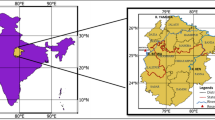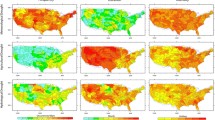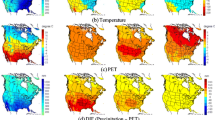Abstract
This study investigates the effect of global warming on drought patterns over Asia at the end of the twenty-first century by a multi-model ensemble method based on daily precipitation data of 15 coupled climate models simulations under SRES A1B scenario, thereby assessing the consistency of responses among different models. The projected precipitation climatology was translated into the change in drought climatology using the effective drought index. The results of the models were consistent in that they project an increase in the mean and the standard deviation of precipitation over most of Asia, and the increase was considerably greater in higher latitude areas. Therefore, it is expected that in future, drought over most of Asia will occur less frequently with weaker intensity and shorter duration than those prevalent currently. However, two special regions were detected. One was the Asian monsoon regions (AMRs: South Asia and East Asia), which showed a greater increase in the standard deviation of precipitation than the mean precipitation, with an amplified seasonal precipitation cycle. As a result, part of the AMRs exhibited slight increases in drought properties such as frequency and intensity. The other region was West Asia. The region showed decreased mean precipitation, especially in its northern part (Syria and its vicinity), and more frequent droughts were projected for this region with enhanced drought intensity and lengthened drought duration. The worsening trends in drought patterns over both regions were more significant in extreme drought, the likelihood of which is relatively higher in summer in West Asia and from spring to summer in the AMRs.










Similar content being viewed by others
References
Akhtari R, Morid S, Mahdian MH, Smakhin V (2008) Assessment of areal interpolation methods for spatial analysis of SPI and EDI drought indices. Int J Climatol 29:135–145. doi:10.1002/joc.1691
Burke EJ, Brown SJ, Christidis N (2006) Modeling the recent evolution of global drought and projections for the twenty-first century with the Hadley Centre climate model. J Hydrometeorol 7:1113–1125
Byun HR, Lee DK (2002) Defining three rainy seasons and the hydrological summer monsoon in Korea using available water resources index. J Meteorol Soc Japan 80:33–44
Byun HR, Wilhite DA (1999) Objective quantification of drought severity and duration. J Clim 12:2747–2756
Gregory JM, Mitchell JFB, Brady AJ (1997) Summer drought in northern mid-latitudes in a time-dependent CO2 climate experiment. J Clim 10:662–686
Hu ZZ, Latif M, Roeckner E, Bengtsson L (2000) Intensified Asian summer monsoon and its variability in a coupled model forced by increasing greenhouse gas concentrations. Geophys Res Lett 27:2681–2684
Jones PD, Hulme M, Briffa KR, Jones CG, Mitchell JFB, Murphy JM (1996) Summer moisture availability over Europe in the Hadley Centre general circulation model based on the Palmer Drought Severity Index. Int J Climatol 16:155–172
Kang KA, Byun HR (2004) On the developing processes of the climatological drought over the East Asia in 1982. J Kor Met Soc 40:467–483
Kim YW, Byun HR (2006) On the causes of summer droughts in Korea and their return to normal. J Kor Met Soc 42:237–251
Kimoto M (2005) Simulated change of the east Asian circulation under global warming scenario. Geophys Res Lett 32, L16701. doi:10.1029/2005GL023383
Kimoto M, Yasutomi N, Yokoyama C, Emori S (2005) Projected changes in precipitation characteristics around Japan under the global warming. SOLA 1:85–88
Kitoh A, Uchiyama T (2006) Changes in onset and withdrawal of the East Asian summer rainy season by multi-model global warming experiments. J Meteorol Soc Japan 84:247–258
Kitoh A, Yukimoto S, Noda A, Motoi T (1997) Simulated changes in the Asian summer monsoon at times of increased atmospheric CO2. J Meteorol Soc Japan 75:1019–1031
Kothavala Z (1999) The duration and severity of drought over eastern Australia simulated by a coupled ocean-atmosphere GCM with a transient increase in CO2. Environ Model Software 14:243–252
Kripalani RH, Oh JH, Chaudhari HS (2007a) Response of the East Asian summer monsoon to doubled atmospheric CO2: coupled climate models simulations and projections under IPCC AR4. Theor Appl Climatol 87:1–28
Kripalani RH, Oh JH, Kulkarni A, Sabade SS, Chaudhari HS (2007b) South Asian summer monsoon precipitation variability: coupled climate model simulations and projections under IPCC AR4. Theor Appl Climatol 90:133–159
Lal M, Meehl GA, Arblaster JM (2000) Simulation of Indian summer monsoon rainfall and its intraseasonal variability in the NCAR climate system model. Reg Environ Change 1:163–179
Lee SH (1998) Flood simulation with the variation of runoff coefficient in tank model. J Kor Water Resour Assoc 31:3–12
Manabe S, Wetherald RT (1987) Large-scale changes of soil wetness induced by an increase in atmospheric carbon dioxide. J Atmos Sci 44:1211–1235
Manabe S, Wetherald RT, Stouffer RJ (1981) Summer dryness due to an increase of atmospheric CO2 concentration. Clim Change 3:347–386
Manabe S, Wetherald RT, Milly PCD, Delworth TL, Stouffer RJ (2004) Century-scale change in water availability: CO2-quadrupling experiment. Clim Change 64:59–76
McCarthy JJ, Canziani OF, Leary NA, Dokken DJ, White KS (eds) (2001) Climate change 2001: impacts, adaptation and vulnerability. Cambridge University Press, Cambridge, UK
Min SK, Park EH, Kwon WT (2004) Future projections of East Asian climate change from multi-AOGCM ensembles of IPCC SRES scenario simulations. J Meteorol Soc Japan 82:1187–1211
Mitchell JFB, Warrilow DA (1987) Summer dryness in northern mid-latitudes due to increased CO2. Nature 330:238–240
Morid S, Smakhtin V, Moghaddasi M (2006) Comparison of seven meteorological indices for drought monitoring in Iran. Int J Climatol 26:971–985
Nakićenović N, Alcamo J, Davis G, DeVries B, Fenhann J, Gaffin S, Gregory K, Gruebler A, Jung TY, Kram T, Lebre LaRovere E, Michaelis L, Mori S, Morita T, Pepper W, Pitcher H, Price L, Riahi K, Roehrl A, Rogner H-H, Sankovski A, Schlesinger M, Shukla P, Smith S, Swart R, VanRooijen S, Victor N, Dadi Z (2000) Special report on emissions scenarios: a special report of Working Group III of the Intergovernmental Panel on Climate Change. IPCC, Cambridge University Press, Cambridge, UK
Palmer WC (1965) Meteorological drought. Office of Climatology research paper 45. US Weather Bureau, Washington, DC
Rind D, Goldberg R, Hansen J, Rosenzweig C, Ruedy R (1990) Potential evapotranspiration and the likelihood of future drought. J Geophys Res 95:9983–10004
Shim SB, Kim MS, Shim KC (1998) Flood inflow forecasting on multipurpose reservoir by neural network. J Kor Water Resour Assoc 31:45–58
Smakhtin VU, Hughes DA (2007) Automated estimation and analyses of meteorological drought characteristics from monthly rainfall data. Environ Model Software 22:880–890
Wang G (2005) Agricultural drought in a future climate: results from 15 global climate models participating in the IPCC 4th assessment. Clim Dyn 25:739–753
Wetherald RT, Manabe S (1999) Detectability of summer dryness caused by greenhouse warming. Clim Change 43:495–511
Wetherald RT, Manabe S (2002) Simulation of hydrologic changes associated with global warming. J Geophys Res 107:4379–4394
Wilhite DA (2000) Droughts as a natural hazard: concepts and definitions. In: Drought: a global assessment Routledge, London, pp 3–18
Xie P, Arkin PA (1997) Global precipitation: a 17-year monthly analysis based on gauge observations, satellite estimates and numerical model outputs. Bull Am Meteorol Soc 78:2539–2558
Yamaguchi Y, Shinoda M (2002) Soil moisture modeling based on multiyear observations in the Sahel. J Appl Meteorol 41:1140–1146
Acknowledgements
We acknowledge the modeling groups, the Program for Climate Model Diagnosis and Intercomparison (PCMDI) and the WCRP’s Working Group on Coupled Modelling (WGCM) for their roles in making available the WCRP CMIP3 multi-model dataset. Support of this dataset is provided by the Office of Science, US Department of Energy. This work was funded by the Korea Meteorological Administration Research and Development Program under Grant CATER 2006-2306.
Author information
Authors and Affiliations
Corresponding author
Rights and permissions
About this article
Cite this article
Kim, DW., Byun, HR. Future pattern of Asian drought under global warming scenario. Theor Appl Climatol 98, 137–150 (2009). https://doi.org/10.1007/s00704-008-0100-y
Received:
Accepted:
Published:
Issue Date:
DOI: https://doi.org/10.1007/s00704-008-0100-y




